Abolishment of Hard Times Part Three
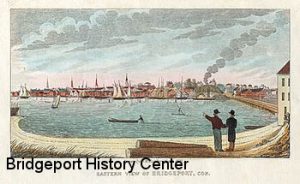
My grandfather, Daniel Wakelee, built a new homestead for this family between 1832 and 1836 in Long Hill, Trumbull, CT. This homestead was on what was called the New Turnpike, and is now the main road running from Bridgeport to Stephney, CT. This new homestead is about five miles from Bridgeport and very near to the old “Long Hill” burying ground.[ii] The house is just on the Stephney side of the lane that runs off the turnpike and goes to the graveyard. To this home my grandparents moved, but a great sickness over took his family. It was at this home that my grandmother would be the first to die of Typhoid Fever.[iii] My grandfather kept a journal starting from 1791, and the last entry he made was 11 Sept 1837 the day after my grandmother died. A few weeks later my grandfather would also succumb to Typhoid.[iv] My grandparent’s third son, Daniel Baldwin Wakelee, who was born on 15 Nov 1814, died next of Typhoid on 18 Jan 1838.[v] The oldest daughter, Mary Ann Wakelee, also had this Typhoid Fever, and was so seriously affected that she hardly regained her full reason through a period of something like ten years.[vi] The loss of so many members of the family made the strain on her much harder. My grandfather was a surveyor and his minutes and plats covered about a generation of time and have been preserved and are in my possession.[vii] The land he surveyed was in and about Trumbull, Fairfield County, CT.
Hard Times
It was with great difficulty that men could get work no matter how skilled in their trades. The times were hard in the North before the Civil War, and there existed what was known as the “1857 Hard Times.” During this period of hard times my father was without work, so he would cut wood for the farmers living out and about Bridgeport. He was an expert with the axe, having acquired this ability to wield an axe when he was a boy working under the control of his father. For two or three generations, the Wakelees had been hewers of timber, which they sold, when prepared at the saw mill, to the ship builders to be used in the construction of vessels.
It was during these hard times that my father solicited of a passing farmer the job of cutting wood and was told to go to work and cut the cord wood at a place about two and one half miles from Bridgeport. My father was so glad for the chance of work that he did not bother about the price to be paid. I went to see my father at work and I remember there was snow on the ground. However, my father cut considerable wood and piled it properly to be measured for the cord. One day my father was home when the farmer was going by and my father ran out to talk settlement. There was a long talk on the highway, old Main Street, before my father came back to the house. He was in a great heat of anger, using oaths in doing so. The farmer wanted my father to take a portion of the wood, and a little money as payment. My father, when aroused to anger, a violent swearer and I remember that on this occasion he did more than swear. He cursed the Country and demanded God to bring blood and revolution upon this country. It is more than likely that the Almighty paid little attention to this prayer, though blood and revolution came soon enough. I could not understand why the conditions were such as to take men so dissatisfied and to make it so difficult for men to live.
The times were hard before the Civil War and these times made a great impression on me. I believed in the abolishment of these hard times. Much was then being said, and since then written and spoken on the abolishment of slavery, but my thoughts was on the abolishment of hard times. These memories led me later to be a strong advocate of pure bimetallism, or the use of the purchasing power of both gold and silver in furnishing the standard of prices in the monetary institution of our Country.
Civil War
Prior to the Civil War I carried and sold newspapers in the City of Bridgeport, CT. I carried a route of the Bridgeport Evening Farmer[viii] and The Standard. For a long time, in the early morning, I took and sold the New Haven Journal. The New York papers reached Bridgeport at the time of about half past nine and I carried and distributed those papers in Bridgeport. The Book Store, from which most of this was done, was owned by E. Lewis, 21 Wall Street, but sometime near the close of the War, he moved around the corner on Maine Street. In this Book Store, was a gentleman by the name of Mr. Fisher who supervised the newspaper business until his death sometime before the War.
The headquarters for the New York papers and the New Haven Journal was from Mr. Lewis store, but the distribution of the Bridgeport papers was from the office of the papers themselves. The Bridgeport Evening Farmer was then on the corner of Wall and Water Streets. I was selling the New Haven Journal at the time of the firing on Fort Sumter. I heard about it in the evening that Fort Sumter had been fired upon and telegraphed to New Haven for a larger supply of papers. In the morning I walked over to Stratford and met the train, which then arrived in Bridgeport at 6-10 o’clock am, therefore giving me a chance to fold my papers. When the train reached Bridgeport, I found a large crowd and they fairly took the papers away from me, so eager were they to get hold of the paper and read the latest news. This was the 12th or 13th of April 1861.[ix]
The times had been very exciting previous to the firing on FortSumter, and just after that came the call from the government of the United States for 75,000 volunteers for three months service. The first Regiment to go through was from Massachusetts and that Regiment reached Baltimore on the 19th of April 1861. The train was fired upon and a fight took place in the streets of Baltimore. The people waited for this Massachusetts Regiment in the thousands and the engine was so arranged as to play some note of a tune. The crowd waited most of the night, and finally, when the troops came a gun was fired, and it went off prematurely, killing one man, I believe, and wounding another.
Enlistments went rapidly and troops went forward as fast as they could be organized under this call for 75,000 men. Soon after the first Bull Run Battle was fought, [x] the time of enlistment of the three months men were expiring. The government had discovered that the call was insignificant as to the numbers and trifling as to the time soldiers would be needed to serve, so they called for 300,000 men for three years, if not sooner discharged. Towards the latter part of July and the month of August 1861, the three months men began to return home. Most wished to go back and re-enlist under the new call. The defeat at Bull Run intensified matters in the North and drew a stronger line between those who advocated the war and those who opposed to it than had been drawn previously.
Political contentions in Connecticut had been very close. The state was generally considered a Democratic one. The election for Governor had been very close and the Republicans carried the State by less than a thousand majority.[xi] Abraham Lincoln spoke two or three times in Connecticut in the Campaign of 1860.[xii] He spoke once strictly on the political issues and on another occasion he gave a reproduction of his famous New York lecture delivered some months previously,[xiii] and on both of these occasions I was there to hear him. Something had been said in regard to it, but no one considered him a probable candidate for the office of President, at the time he was in Connecticut.
The Stephney, CT ‘Peace Flag’
The vote for the Presidential election of 1860 in Fairfield County, CT, was quite large for Breckenridge, the original Democratic nominee.[xiv] This was the ticket supported by the Bridgeport Evening Farmer, a newspaper generally called the Farmer, a daily and weekly newspaper. This paper was edited and perhaps owned at this time by a firm know as Pumoroy & Morse.[xv] Pumoroy was an old man and lived in Bridgeport in a fine house somewhere there on Golden Hill. This paper, under the management of Mr. Morse, was actively opposed to the war and was as near in sympathy with the Secession Movement as it possibly could be without open proclamation to that effect.
I was in the printing office of the Farmer to learn the printing trade and was known in that office as the Devil. I remember carrying the editorial up to Mr. Pumoroy’s house and waiting for him to glance over and pass upon or make such modifications as he choose, and then I would return it to Mr. Morse. This paper particularly exasperated the returned three-month men. There had been treats to mob this paper and to do harm to Mr. Morse. There had been some preparations to meet such a force and a few men stayed in the Farmer office overnight. They had two or three barrels of clubs, like policemen’s clubs, ready to use in case of an emergency.
This leads me up to a celebrated part of the history of Bridgeport, which is the mobbing and destruction of this printing office.[xvi] P. T. Barnum, who was for years charged with being one of the chief instigators of this act, took a great part in it to my personal knowledge. He had, associated with him in this act, Mr. Elijah Howe, the inventor of the sewing machine. Mr. Howe had brought the old Barnum place and built a house there. He was a well-known citizen at the time of Bridgeport. On a certain, I cannot remember the exact date,[xvii] I went out on some business and saw several carry-alls, busses and large carriages gathered in front of what was then known as the Sterling House situated on Maine Street facing Wall Street. I inquired as to what all this meant, and I was told that a party was going up to Stephney to take down the Peace Flag.
The Peace Flag needs an explanation. The opposition to the Civil War in the North, at least in New England, in the late summer and fall of 1861, took the form of great peace meetings. I believe a man named Reynolds, editor of the New York Times, had suggested this form of protest against the war fever of the North. There would be a great demonstration, with speeches, singing and feasting, and in place of the Liberty Flag, there would be raised on a pole a great white flag as a sign that the meeting advocated peace. There was one of these meetings, advertised far and wide, being held at Stephney.
Mr. P. T. Barnum and Elijah Howe and others were mounted on horseback and men were beginning to fill up these conveyances. There were not many large conveyances in Bridgeport, so these were very likely, from Mr. Barnum’s show. They were filling up with men and most of them were the returned three-month volunteers and they stored a good many arms as they entered. I managed to get into one of wagons and stored myself so as not to be driven out by the older men and went on that celebrated ride to Stephney.
The ride to Stephney was made in quick order. When we went driving up to the pole on the Stephney Green, the large assembly was hearing a prayer, their heads bowed, and the meeting was being opened with that prayer. We were two or three hundred feet or so from where they raised the Peace Flag. As more carriages drove up full of men, the new arrivals took positions around the pole. Someone had to climb up some distance to get hold of the rope so as to let down the flag, as it was not designed for the flag to be removed until it wore out.
When the people began to realize that an enemy had come to take down the flag. The most determined men came up to oppose and several of them went to their homes for their guns. The new comers sought to disarm them as soon as they appeared and this caused several struggles in the broad road. Back in the field some firing took place and finally the Sheriff came in and sought to arrest such as he could get hold of, those that were found armed and firing. The new comers took them away from the Sheriff, and he called on the assistance from the people and he got some, but not sufficient to enable him to bring things to a peaceable condition. There were plenty of arms and the blood of the men was up and they were ready for a sort of general engagement.
The flag was taken down, however, and torn up into treads and tied to the wagons. After an hour passed, the procession started back again to Bridgeport. It was constantly augmented by arrivals of teams and men on horses, and when we reached Bridgeport, about eleven miles from Stephney, some in the large procession was entirely intoxicated. All were excited over the victory at Stephney and were ready for something worse on reaching Bridgeport if there were leaders.
P.T. Barnum Admits Being at Stephney, CT
Let’s interrupt Ebenezer’s re-telling of the Stephney “Peace Flag” incident by adding a confirmation of the event by P. T. Barnum himself. According to “Struggles and Triumphs”, also called, “The Life of P. T. Barnum” written by P. T. Barnum and combined into a single volume in 1927 by George S. Bryan, Barnum wrote, “I began my political life as a Democrat, and often declared that if I thought there was a drop of blood in me that was not Democratic, I would let it out if I had to cut the jugular vein. When, however, secession threatened in 1860, I decided to identify myself with the Republican Party.
[i] Excerpts from Memorandum of Comrade E. Wakeley’s Family History: Since They Were Known in America by Ebenezer Wakeley, Jr., un-published 41 page pamphlet written in Chicago, IL before 1902. He mentions in his history that his father was “still living” at the time of its writing. His father died in 1902.
[ii] According to the will of Daniel Wakelee a saw mill was located on the southern part of the estate. A photo of this home is in the editor’s collection. It was sent to Ebenezer “Eben” Stone Wakeley on 11 Dec 1918. The photograph was taken by a cousin, Charles Wilcoxson of Stratford, CT, the son of Mabel Wakelee (born 7 Jan 1813), and Lucius Wilcoxson of Stratford, CT.
[iii] Mary (Baldwin) Wakelee, born 5 June 1781 and died 10 Sept 1837, is buried at the LongHillCemetery next to her husband Daniel, and his parents, David and Mary (Burton) Wakelee. Mary’s parents are unknown at this time.
[iv] Daniel Wakelee, born at Stratford, CT 12 Nov 1772, the son of David Wakelee (born 4 Oct 1739 and died 18 May 1822) and Mary (Burton) Wakelee (born 21 Oct 1746 and died 12 May 1803). Mary Burton’s parents were Captain Joseph and Rebecca (Booth) Burton and they are also buried at Long Hill Cemetery. Daniel died 26 Oct 1837, and is buried next to his wife Mary at LongHillCemetery. A copy of the last will and testament, and the estate distribution listing is in the possession of editor.
[v] Daniel Baldwin Wakelee is also buried at LongHillCemetery.
[vi] Mary Ann Wakelee, born 20 Feb 1805 and died 17 Nov 1870, is also buried at LongHillCemetery. She never fully recovered from the death of her parents and brother, and would never marry. She lived out her days at her brother George Wakelee’s (also buried at Long Hill Cemetery) home.
[vii] According to the will of Daniel Wakelee he left these survey records to his son Daniel Baldwin Wakelee (who would die himself of Typhoid). The surveys were maintained in five books and contained the surveys of over 1000 different tracks, and the records of many inventories and distributions. Unfortunately, these valuable survey records, and the family journal mentioned above, have been lost to our family.
[viii] Before its destruction in 1861 this newspaper was known as the Daily Advertiser and Farmer (1856-1861), published by Pomeroy & Morse, and it reopened in 1864 as The Evening Farmer (1864-1866), but it was also called the Daily Republican Farmer, and/or Bridgeport Daily Farmer, published by William S. Pomeroy. In 1866 the paper became known as The Bridgeport Evening Farmer (1866-1917), published by Pomeroy, Gould, & Co. [See http://chroniclingamerica.loc.gov ]
[ix] According to Civil War Regiments from Connecticut, published in 1908 by Federal Publishing Company, the news that FortSumter had been fired upon reached Connecticut on Sunday morning, April 14, 1861. The firing on Fort Sumter commenced on April 12 and the Fort surrendered on April 13, 1861.
[x] The 1st Battle of Bull Run was fought July 21, 1861.
[xi] Republican Governor William Alfred Buckingham won re-election in 1860 by just 541 votes against Democrat Thomas H. Seymour.
[xii] Abraham Lincoln spoke in Hartford, CT, 5 Mar 1860, New Haven, CT, 6 Mar 1860 and Bridgeport, CT, 10 Mar 1860. The Bridgeport speech was given at McLevy Hall, near the corner of State and Broad Streets, in an auditorium called Washington Hall. The speech was not recorded, but it was said to be based on his 27 Feb 1860 speech in New York City.
[xiii] Abraham Lincoln spoke in New York City at the Cooper Union on 27 Feb 1860 before a crowd of 1,500.
[xiv] In the Fairfield County, CT, 1860 Presidential race Lincoln received 54% of the vote, Breckenridge 17%, and Stevens 10%. According to an article by Jon Grinspan, in the Journal of American History, Volume 96 (Sept 2009), pages 357-78, of all the Northern states, Connecticut would give Breckenridge his highest vote percentage. In Bridgeport, CTLincoln received 1110 votes to Breckenridge’s 462, and Steven’s 475.
[xv] According to an article by Christine Scriabine called Communications and the Media in Connecticut found at www.ctheritage.org, the Bridgeport Evening Farmer was edited by William S. Pomeroy and Nathan S. Morse. After the destruction of the paper Morse was driven from the state, but Pomeroy would resume publication in 1864, but avoided all provocative editorials (also see footnote xiii).
[xvi] The Bridgeport Farmer was “silenced when it was attacked and sacked by an indignant body of citizens and soldiers on August 24, 1861.”
[xvii] As noted in footnote 10, the date was August 24, 1861.
Abolishment of Hard Times: Part Two

Written by Ebenezer Wakeley, Jr. (1843-1916)
Edited by great-great grandson Gregory Robert Cunningham
My father, Ebenezer Wakelee, the son of Daniel Wakelee and Mary Baldwin, was born January 13, 1818. He married Mary Jennings of Greenfield Hill, CT, who was the daughter of Seth Jennings who lived in Easton, Fairfield County, CT, and died there in the year 1871. My parents were married in 1841. I was born in Trumbull, Fairfield County, Connecticut, on December 17, 1843. I was the second of six children. When I was born the house my father was building was between the two turnpikes on land inherited from the estate of his father.It was not ready to be occupied and we were living in an old house on the New Turnpike. The first remembrance of life was in the new house that my father had built. Here the family lived until they moved to Bridgeport in 1852.
Hard Times
It was with great difficulty that men could get work no matter how skilled in their trades. The times were hard in the North before the Civil War, and there existed what was known as the “1857 Hard Times.” During this period of hard times my father was without work, so he would cut wood for the farmers living out and about Bridgeport. He was an expert with the axe, having acquired this ability to wield an axe when he was a boy working under the control of his father. For two or three generations, the Wakelees had been hewers of timber, which they sold, when prepared at the saw mill, to the ship builders to be used in the construction of vessels.
It was during these hard times that my father solicited of a passing farmer the job of cutting wood and was told to go to work and cut the cord wood at a place about two and one half miles from Bridgeport. My father was so glad for the chance of work that he did not bother about the price to be paid. I went to see my father at work and I remember there was snow on the ground. However, my father cut considerable wood and piled it properly to be measured for the cord. One day my father was home when the farmer was going by and my father ran out to talk settlement. There was a long talk on the highway, old Main Street, before my father came back to the house. He was in a great heat of anger, using oaths in doing so. The farmer wanted my father to take a portion of the wood, and a little money as payment. My father, when aroused to anger, a violent swearer and I remember that on this occasion he did more than swear. He cursed the Country and demanded God to bring blood and revolution upon this country. It is more than likely that the Almighty paid little attention to this prayer, though blood and revolution came soon enough. I could not understand why the conditions were such as to take men so dissatisfied and to make it so difficult for men to live.
The times were hard before the Civil War and these times made a great impression on me. I believed in the abolishment of these hard times. Much was then being said, and since then written and spoken on the abolishment of slavery, but my thoughts was on the abolishment of hard times. These memories led me later to be a strong advocate of pure bimetallism, or the use of the purchasing power of both gold and silver in furnishing the standard of prices in the monetary institution of our Country.
African American History:Can you help Identify these People?
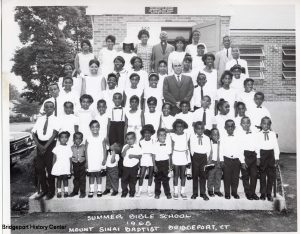
We need your assistance! We have photographs which we need to identify for cataloguing.
We will be posting photographs for you to help us identify If you can assist us…please give us the names of individuals. Drop by the History Center or send us the names of individuals that you are able to identify.
We will post a new photograph every week…help us out!
Who are the persons in this photograph?
Please identify left to right.
Call (203) 576-7417
Alice Whiting Farrar and Geraldine Farrar Johnson
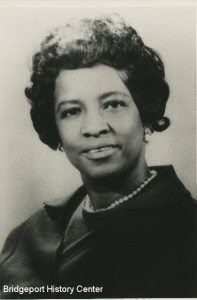
By Mary K. Witkowski
Editor: Ann Marie Virzi
Alice Whiting Farrar had many passions: music, church, education and above all, her family and their home on Bridgeport’s East End. Skills she learned at a young age, especially sewing,served her well as a mother running a household with her husband Edward Langston Farrar and their seven children.
Alice and Edward Farrar set high expectations for their children, including their third oldest, Geraldine Farrar Johnson, who would go on to become Bridgeport’s first female and African-American schools superintendent. (more…)
Baldwin Plaza in 1974
Directly behind what was then the new state courthouse building, a plaza costing around $1million was built. Dedicated at a ceremony on October 10, 1974, the plaza was named after former Connecticut governor Raymond E. Baldwin Sr.
The ceremony was held in the new plaza, with then mayor Nicholas Panuzzio giving former Governor Baldwin the keys to the city. Also in attendance was Superior Court Judge Otto H. La Macchia and Bridgeport Bar Association President C. David Munich.Governor Baldwin was governor of Connecticut from 1939 to1941 and from 1943 to 1946. Governor Baldwin, on the far left, was 81 years old at the time of this ceremony. When working as a lawyer for Pullman Comley in 1924, Baldwin lived on Savoy Street in Bridgeport’s North End for a short time He was a resident of Stratford.
Raymond E Baldwin Sr. died October 4, 1986. He was buried in Middletown.
Photo: Baldwin Plaza Dedication ceremony, October 10, 1974
Beardsley Park and Zoo
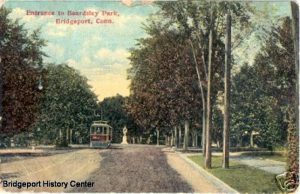
Beardsley Park :”A Place that Would Always be Theirs”
By Eric D. Lehman
After the success of Seaside Park, Bridgeport was ready to put aside more land for the enjoyment and refreshment of its citizens. When wealthy cattle baron James W. Beardsley donated over one hundred acres of land in 1878, he gave it on the condition that it “shall accept and keep the same forever as a public park.” He had been inspired one day while watching local children play outside, and decided they deserved “a place that would always be theirs.” Located at the north end of Bridgeport along the Pequonnock River, the land also contained the highest point in the city limits. So, in 1881 the designer of Seaside Park, famous architect Frederick Law Olmsted, created a plan for a “pastoral” park, using the existing contours of land in what was called “rustic arrangements of boulder and parterre.”
Soon citizens relaxed on lawns shaded by European beeches and took dips in the wide expanse of Bunnell’s Pond. A replica of William Shakespeare’s home, the “Anne Hathaway Cottage” was built in the park on the 300th anniversary of the author’s death. In the years in which Barnum and Bailey circus had its winter quarters in Bridgeport, animals like zebras, camels, and elephants were exercised in the park. This heralded the park’s future, and in the year 1920, City Parks Commissioner Wesley Hayes began the process of creating a zoo.
Beginning with exotic birds from local citizens and circus retirees from Barnum and Bailey, the zoo grew quickly. At first, it was a “drive-through” zoo, where visitors could literally see the exhibits without leaving their cars. The city invested $50,000 to build a large greenhouse, and some animals stayed in its warm confines during the winter months, Soon, monkeys, leopards, and llamas joined more unusual animals like silver foxes and tree ducks. In 1997 the Connecticut Zoological Society bought the zoo from the city and runs it as a nonprofit institution. Today it is still the only zoo in the state of Connecticut, with one of the largest greenhouses and a rare carousel.
The park itself remains a place of refreshment and relaxation for the city’s residents. As designer Frederick Law Olmsted said, it is “just such a countryside as a family of good taste and healthy nature would resort to, if seeking a few hours complete relief from scenes associated with the wear and tear of ordinary town life.” A statue of James Beardsley by Charles Henry Niehaus was erected in 1909 and remains at the entrance to the park, watching over the land he donated, land that will “always be theirs.”
Want to learn more about Beardsley Park and Zoo? The Bridgeport History Center has the following materials available:
— Bridgeport: Tales from the Park City. By Eric D. Lehman (Charleston, SC: The History Press, 2009.)
— Connecticut’s Beardsley Zoo. By Robin Demattia (Bridgeport: Connecticut Zoological Society, 2002.)
— History of Bridgeport and Vicinity. By George Curtis Waldo. (New York, S.J. Clarke, 1917.)
— Bridgeport History Center, Newspaper clipping filr; Parks-Beardsley Park and Zoo.
Bridgeport History Center, Photographs, Beardsley Park and Zoo
Black Market Rally Bridgeport:1943
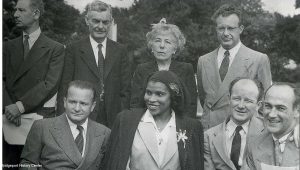
Rationing of many products during World War II, such as food items, gasoline, and coffee, caused a surge of the black market--goods traded illegally. In August 1943, a rally in Marina Park was held to protest the black market. Shown in attendance in the rally are from left to right, the following: (front row) Franz Rupp, pianist; Marian Anderson, opera singer; Bud Hollick, comedian;Carl Frank, radio announcer and actor; (back row) Franklin P. Adams; columnist and quiz expert; Mayor Jasper McLevy; Edna Ferber, novelist; and Clifton Fadiman, book reviewer for the New Yorker.
Bridgeport Lighthouse
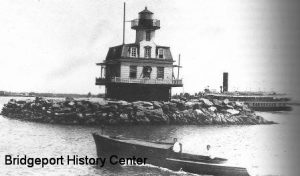
The Bridgeport Lighthouse, shown here in 1930, marked the entrance to the Bridgeport harbor for about 80 years.
First constructed in 1871 by the federal government, it ushered in a dramatic increase in harbor activity. (more…)
Bridgeport Soap Box Derby
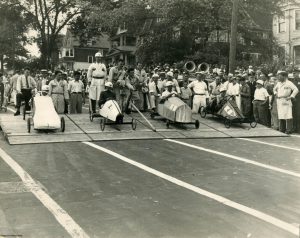
Imagine racing down Boston Avenue in a home made, four wheeled, handmade miniature racing car! Bridgeport’s Soap Box Derby was run on July 25, 1936 over a course that was 1,050 feet long. The course ran along Boston Avenue between North Summerfield Avenue and Success Avenue.
Cochrane Cheverolet Company cosponsored the race with Post Publishing Company. The Bridgeport Police Department helped to regulate the race, re-routing traffic so that the Boston Avenue hill was a smooth, four lane course.
Entrants in the race had to be between the ages of 9 and 15 years old. The local champion would compete in the All American finals in Akron, Ohio in August of 1936. No car that was entered in the race could exceed 75 inches in length over all. All racers must have had rubber tired wheels, with a maximum diameter of 15 inches.
The entire car had to be hand built, however the cost of making the car had to be under $10.00! Some of the rules set up in making the cars were as follows: wheels could be home-made, second-hand or newly purchased in stores that specialized in Derby wheels; overall height of the car may not exceed 30 inches. Brakes were mandatory on each car…the “drag” type of break was the simplest for the soap box racer. By pressing down on the brake rod with the foot, the brake pad at the end of the rod drags on the ground and stops the car.
Special awards were given for best racing design and the most “unique” entrant. Mayor Jasper McLevy was the Honorary chairman of the event and the race director was W. Ben Aurandt.
150 boys entered the race. 15,000 spectators lined up and down Boston Avenue to watch the race. It was 13 year old Richard Moore who won the City Championship. Richard told reporters that it took him six weeks to build his red racing machine, and it cost $3.84 cents to assemble the car!
Three of the young drivers were injured, receiving lacerations on their legs, and were rushed to nearby Bridgeport hospital.
Bridgeport Titanic Survivor Drowns in Beardsley Pond?

Photo: Oscar Palmquist
In April of 1912, the news of the tragedy of the sinking of the ship Titanic resonated throughout the world. In the New York metropolitan area, the many immigrants and their families shuddered to think of the sad drownings. Many area residents themselves traveled over from Europe and other countries by boat. It was a difficult trip, one of hardship for many, as they left their homeland to take their chances on a new life overseas in America.
Those who died were listed in the newspapers in the days following the tragedy. The horrible news that came back was described too grimly in the newspapers. The Bridgeport Post reported; “The faces of the dead were set in expressions of horror and extreme fear, and legs and arms were bent and contorted, show how madly they had fought for their life in the icy water.”
There were survivors of the shipwrecked Titanic. One survivor, Oscar Palmquist, managed to jump into the icy waters as its final six feet sunk into the Atlantic. Oscar’s brother, Amandus, gave the account of Oscar’s rescue to the Yonkers Herald, April 22, 1912. “He tied two life belts around his waist, knowing that the suction as the boat went down would make the chance of getting away from her very small.”
Oscar was in the freezing water for more than five hours before being rescued by the Carpathia. He was assisted by a young woman in one of the lifeboats. The Swedish girl, who let him hold onto her shawl like a rope from the lifeboat, later died from exposure.
Oscar and his brother Amandus first lived in Yonkers, but later moved to Bridgeport, Connecticut. Oscar Palmquist, a single man, lived on Bassick Avenue and worked in a local factory. On March 23, 1925, Palmquist was reported missing, and was found dead in Beardsley Park reservoir by park employees on April 19, 1925.
Even though the Bridgeport police reported the cause of his death as drowning, Larsen’s funeral home said the body had not been submerged in water that long. The family of Palmquist felt that it had been foul play. A nephew of Oscar Palmquist, Robert Palmquist told me recently that “Oscar never went near the water after the Titanic disaster. He also was a strong man and would not have drowned in a pond.”
In 1925, as fairly recent immigrants to Bridgeport, the family did not pursue Oscar’s death any further, because it may have caused friction for the family.
Bridgeport Tornado of 1876
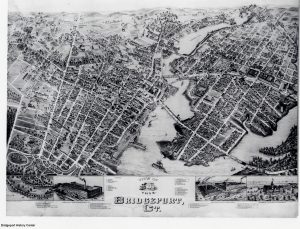
Bridgeport’s 2010 tornado was not the first tornado the city ever had. A tornado tore apart parts of Bridgeport and Stratford 136 years ago. The storm had an eerie resemblance to our 2010 tornado, moving quickly and as suddenly as that storm hit and on a similar path of destruction. In the middle of the night on September 14, 1876 residents of parts of Bridgeport were awakened by a windstorm passing through town. Around midnight, buildings began to shake. The tornado, which was reported in the Bridgeport Standard the next day, had reporters tracking the storm through Highland Avenue in the City’s Hollow where three houses were unroofed, plus the timbers and tin roof coverings of two other houses were torn off.
The next stop for the storm was at Housatonic and East Washington Avenues, where a huge willow tree fell down, falling on telegraph wires. Lumber scattered everywhere from the Lyon, Curtis and Company lumberyard. Lumber owned by the Wheeler and Wilson Company also blew throughout the area.
The gale hit the carriage shop at the corner of William and East Washington, and turned southeast, tearing a corner of the building away. Then the storm hit Washington Park, leaving a large tree down and a trail of broken limbs and chimneys.
It was also reported that damage occurred in West Stratford.
The storm was a whirlwind, which seemed to be a couple of hundred feet wide at any point. The wind was quick moving, and only lasted a few minutes. It was later reported to be a tornado.
The tornado of June 24, 2010 damaged buildings throughout Bridgeport. The Barnum Museum was heavily damaged and is currently closed for repairs. But the Museum’s gallery in the People’s United Bank is open for the public to view the restoration and conservation process from 11am to 3pm on Thursdays and Fridays. For further information call the Barnum Museum at (203) 331-1104.
Bridgeport Train Wreck, July 11, 1911
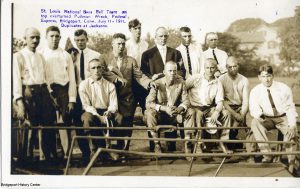
On July 11, 1911 the Federal Express Train wreck, one of the worst railroad wrecks in Bridgeport’s history occurred around 3:15 that summer morning. On board was the St. Louis Cardinals National baseball team, as well as many other passengers.
The train, which had been running late, was run by a crew trying to make up time. A crossover switch was missed, and the train jumped the track and tumbled down a 20 foot embankment, near the intersection of Fairfield Avenue bridge near state street.
The scene was one of immediate horror. The dawn brought to light the twisted metal of the train, with bodies strewn throughout the rubble.
At least 13 people were found dead in the wreck; many more were seriously injured. Pieces of the train were strewn in the back yards. The locomotive and five train cars were destroyed.
The site of the train wreck was recorded in photographs, with local citizens poised in front of the debris.
Many of the photographs were made into postcards and sent throughout the country. In 1955, The Federal Express train crashed again in Bridgeport. There was only one casualty.
Bridgeport Working:Voices of the 20th Century
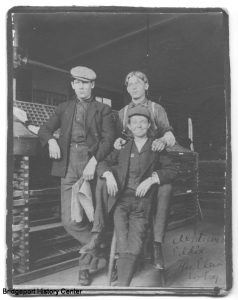
The Bridgeport History Center created a website documenting the lives of the people who worked in Bridgeport, Connecticut in the 20th century. Help us celebrate the lives of the people who worked here to make Bridgeport one of the instrumental labor cities in the Northeast.
Click above to explore Bridgeport’s labor history.
Bridgeport, Connecticut The “Right” Flight
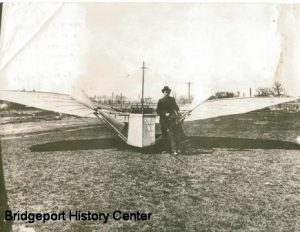
We Believe!
The recent article written in Jane’s All the World Aircraft that verifies Gustave Whitehead flew his plane on August 14, 1901.
We here at the Bridgeport Public Library’s History Center have scads of articles on file that support this.
We Believe in Gustave Whitehead!
Here is an article that was in this blog that celebrated the 110th anniversary of Gustave Whitehead an his miraculous flight. Miracles do happen!
Gustave Whitehead near plane
1874-1927
Bridgeport resident Gustave Whitehead made his first solo flight August 14, 1901. Why is he not known as the “Father of Flight?” This year marks the 110th anniversary of Gustave Whitehead’s historic flight.
One of the best articles on Whitehead’s flight appeared in Popular Aviation magazine in January 1934, with the headline, “Did Whitehead Precede Wrights in World’s First powered Flight?”
The article, written by researchers Stella Randolph and Harvey Phillips, tells the story of Bridgeport resident Gustave Whitehead and his flying machine, known as 21.
According to the 1934 article, the plane Whitehead used for his initial 1 1/2 mile was a mono plane with a four cylinder, two-cycle motor located in the forward motor located in the forward part of the flying device.
The plane’s ignition was of the make-and-break type, and Columbus dry batteries were used. The gravity-fed gas tank held two gallons of petrol.
The wings were the most amazing sight, covered with Japanese silk, and varnished and fastened onto bamboo struts.
Whitehead, a mechanic, was one of the few men pursuing powered flight who worked on both the motor and the actual plane. He poured all of his financial resources into constructing the plane.
He wanted his plane to be perfect, and kept wrestling with the motor and plane until he got it right.
Whitehead continued to work on his plane at his Pine Street home after the summer of 1901. In early 1902, he flew his plane on trips of two miles and seven miles over Long Island Sound.
In comparison, the Wright Brothers “first” flight in December 1903 in Kitty Hawk, N.C. was only 852 feet, and lasted only 59 seconds.
Why is Whitehead not better known for his invention?
Whitehead, a German immigrant, quietly conducted his experiments. While his friends and neighbors were familiar with his work, he flew his plane early in the morning and there were few observers.
According to the Popular Aviation article, the Wright Brothers had independent means,” the article said, “they had the encouragement of people in the same field, they belonged to organizations where there work would find reception and publicity, they spoke English fluently and their background was such that they knew how to use it skillfully to carry their audience with them.
Just as Ohio takes pride in their hometown boys, Orville and Wilbur Wright, Bridgeport,Connecticut should celebrate Gustave Whitehead. Note: The Wright brothers visited Whitehead and discussed his experiments.
Mary Witkowski
Bridgeport City Historian
Bridgeport’s Rosie the Riveter
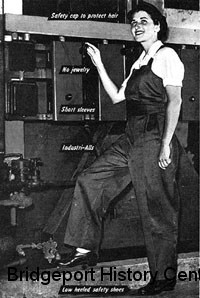
Marge Schneider should be an inspiration to young women today. During World War II, Marge Schneider lived with her family on Barnum Avenue near Central. With the flurry of war around her, Marge took a job at the Bridgeport Brass Company on Grand Street. Marge walked to work. (more…)
Charles Ritchel

Photo: Charles Ritchel c. 1840-1911
Charles Ritchel was an inventor who is credited with inventing the first dirigible. In 1878, Ritchel built a hand-powered dirigible fashioned out of rubber from the Goodyear Rubber Company in Naugatuck and the Folansbee Machine Shop in Bridgeport, Connecticut. He is a Bridgeport inventor who is also thought to have invented roller skates.
Corbit Studio

By: Mary K. Witkowski, Bridgeport City Historian
Corbit Studio, Photograph property of Bridgeport History Center, Bridgeport Public Library
Lewis Corbit Sr. and later his son Lewis Jr. were responsible for documenting almost a century of Bridgeport history.
Lewis grew up in South Britain, Connecticut, where he worked as a young man in the Spaulding Bicycle shop. He moved to Dover, New Jersey and opened a photography business.
In 1906, Lewis H. Corbit moved to Bridgeport, Connecticut. After opening up photo studios in two other locations, he finally settled on 2 Elm Street. Lewis H. Corbit continued running his photo studio with his family.
This 1934 photograph shows Lewis Corbit, Jr. on the right and the eldest son Lawson Corbit center. The photo studio at 2 Elm Street was crammed with photographs and equipment. Many Bridgeport residents got their picture taken at Corbit’s Studio.
Corbit’s Studio was a presence in Downtown Bridgeport for most of the 20th Century.
Source: Bridgeport History Center, newspaper clipping file,Corbit
Dutch Schultz

The gangster Arthur Flegenheimer, more commonly known as “Dutch Schultz,” came to Bridgeport April 30, 1935.
Schultz and his bodyguard, Lulu Rosenkrantz, occupied the fourth floor suite at the Stratfield Hotel on Main Street downtown.
Schultz was interviewed by local reporters in the suite. One reporter said that Schultz gave the interview “more gracefully and with more poise than some of the persons in less exciting professions than his.”
Dutch Schultz had a long criminal history, including overseeing a successful bootlegging operation. During the Prohibition years, his selling of illegal liquor was widespread.
Even in 1933 at the end of Prohibition, his control of the crime racket in New York City was notorious.
Schultz was indicted in 1933 for tax evasion. He was accused of not filing tax returns for 1929,1930 and 1931. By this time FBI Director J. Edgar Hoover named Schultz “Public Enemy No. 1.”
In November 1934, Schultz surrendered to authorities, and although he tried to pay his taxes, the government put him on trial on April 16, 1935 in Syracruse, New York. A judge dismissed the jury on April 29 when they became hopelessly deadlocked.
Schultz showed up in Bridgeport two days later. While city residents might have had visions of gangland street fights in front of the Stratfield Hotel, Schultz told reporters that “He was resting here, and he “Had no worry.”
Although Schultz was not known for his wardrobe, and was once described by Lucky Luciano as a “guy with a couple of million bucks who dressed like a pig,” a Bridgeport reporter said Schultz was tastefully dressed in “various shades of blue, except for his shoes.”
One socialite told the New York Sun that “My dear Arthur was the answer to a hostess’ prayer. When it became known that he was invited to your party, you had nothing to worry about. Everyone came…and really, he was charming. It was hard to believe all those horrid stories.”
Schultz rode horseback in Fairfield, went to the movies, and hung around in front of the Stratfield Hotel watching passerbys with his friends.
The Bridgeport Herald reported that he would often invite women upstairs to his suite to have a drink with him. One young lady told a reporter that “if news leaked out that I even talked to Schultz, my family would kill me. And my boyfriend would break my neck. I just wanted to see him for the thrill of it.”
“I was convinced that he was just a bum who made a lot of money easy,” the woman continued. “We never did anything out of the way,” she said. “There was always a lot of people around when I saw him. We kidded a lot. He was plenty funny. Never nasty although he liked to slap me in the darndest places.”
Schultz said of his stay in Bridgeport, “I’ve been treated very kindly, and have met some very lovely people.”
Then Mayor, Jasper McLevy said, “As long as Schultz behaves him self, he won’t be bothered in Bridgeport.”
On September 24, 1935, Schultz left Bridgeport. One month later, Dutch Schultz was gunned down in a tavern in Newark, New Jersey. He died 22 hours later.
Elias Howe, Jr.
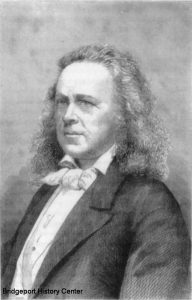
Elias Howe Jr, invented the first practical sewing machine in 1845. Howe opened a factory along the banks of the Pequonnock River in 1863. The factory was located on the east side of the Pequonnock River.
The factory produced as many as 400 sewing machines a day. Howe’s building was a beautiful domed building with a fountain in front of it. He had his own dock for direct shipping to and from New York. A fire in 1883 destroyed the main building.
Elias Howe was the first person from Bridgeport to sign up for the Civil War, however Howe was 42 years old and in ill health. He served as a private in Company D of the 17th Connecticut Volunteers, but he never served in combat due to poor health.
Elias Howe died three years after enlisting. The Grand Army of the Republic Post in Bridgeport was named after Elias Howe, Jr. His son Simon was in charge of the factory after his death.
Want to learn more about Elias Howe, Jr.? The Bridgeport History Center has the following materials available:
Books:
Bridgeport at Work, Witkowski, Mary K. Arcadia Publishing, 2002.
Pictorial History of Bridgeport, Palmquist, David
Bridgeport History Center, Newspaper Clippings, Biography: Howe, Elias Jr.
Family Tree Stories
We have had thousands of visitors and thousands of wonderful genealogy stories told to us by our researchers. We will share some of the stories here.
Fanny Crosby
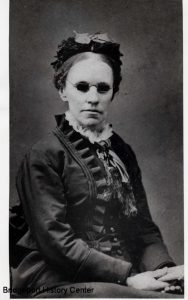
Fanny Crosby, whose formal name was Francis Van Alstyne, was one of the corner stones of Bridgeport and a beacon for Bridgeport women.
Her creative ingenuity inspired people all over the world, and her songs have been sung by generations of church-goers.
As early as age 8, Crosby began to write poems. She attended the New York Institute for the Blind, where she eventually taught. When she was still a teacher, an 18-year old named Grover Cleveland, who also was employed at the school, worked with Crosby in transcribing her poems. Cleveland was later elected President of the United States.
By age 24, Crosby had her first book of poems published. She went on to write songs and hymns–more than 8,000 of them. Many of her hymns are still sung, such as “Safe in the Arms of Jesus,” and “Blessed Assurance.”
The following words, written when she was 8 years old, sum up Crosby’s positive outlook on life that inspired many:
Oh, what a happy soul I am,
although I cannot see!
I am resolved that in this world
Contented I will be.
How many blessings I enjoy
That other people don’t.
To weep and sigh because I’m blind
I cannot, and I won’t!
Fanny Crosby died in 1915 at the age of 94. She is buried in Mountain Grove Cemetery in Bridgeport. She is considered one of the most prolific hymn writers of the 20th century.
Friends or Sisters? Who Are They?
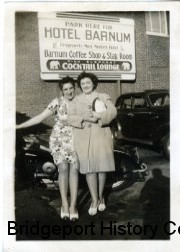
A patron from Milford sent me a photo the other day. She said she found the photo with no information.
From time to time, photos are donated, with very little information. (more…)
General William Henry Noble

General William Henry Noble
by Eric D. Lehman
Born in 1813, William Henry graduated from Yale University with a law degree at age twenty-three. After returning to his home town of Bridgeport, he was admitted into the bar and helped the city of Bridgeport secure its charter. He taught French and Spanish in his father’s school on Golden Hill, but his career blossomed when he became the secretary of Bridgeport Savings Bank in 1842, then the state’s attorney in 1846. When his father died, he inherited land in East Bridgeport and entered into an agreement with P.T. Barnum to develop it, assisting the construction of houses, hotels and factories.
Then, on April 14, 1861, Fort Sumter fell, beginning the War of the Rebellion. Unlike Barnum, Noble was a conservative Democrat, and thus on the “wrong side” politically to serve in the Union army. But that did not stop him. He saw the necessity for preserving the Union, and turned against those in his political party who sympathized with the Southern rebellion. He served the cause of Lincoln because it was “the cause of the Union.” He said after the disaster at Bull Run, “The soul of the North, unflinching before disheartening reverses, aroused to mightier effort.”
Noble was commissioned colonel of the Seventeenth Regiment of Connecticut Volunteers. With one thousand men in the regiment under his command, he noted, “It was from the start known as the Fairfield County Regiment. With few exceptions, its ranks were filled by her sons.” Inventor of the sewing machine Elias Howe signed up for this regiment, though his age and health prevented him from serving. On August 28, 1861, the regiment was mustered in what is today Seaside Park, and left for Washington D.C.
The 17th fought at Chancellorsville against Stonewall Jackson, and Noble’s horse was killed from underneath him, while a shot hit his arm and a shell fragment cut his left knee badly. Luckily, his artery clogged and he did not bleed to death. He said, when recounting the battle: “The crushing force of Stonewall Jackson’s attack was in such irresistible mass, with such steady and unabating fire, that the air seemed full of whizzing rifle-balls. Their advancing light artillery threw a storm of shells down the lines of retreat.”
Noble recuperated in Bridgeport for over a month, while his men marched to Gettysburg. But, although he was far from healed, he left his bed at home and rushed to the upcoming battle. His regiment was stationed on the edge of town, and by the time he got there things were mostly decided. He marched into the town with the 17th on Independence Day, after losing 206 men.
The 17th shipped out to South Carolina and then Jacksonville, Florida. Noble assumed command of the Second Brigade, and the Seventeenth moved to St. Augustine to conduct foraging raids. He was captured on Christmas Eve of 1864. Later, he said, “The attack was sudden and unexpected. They are easily made so in Florida, which is pretty much all one pine wood.” He survived the notorious Andersonville Prison Camp, as the highest ranking imprisoned officer. In his old age he would often remember the horrors of that “snakepit” with a shudder and a curse.
After the war, General Ulysses S. Grant brevetted William Noble a brigadier general in the Union army. However, Noble did not serve after the war. He returned to a law career in Bridgeport and helped veterans and their descendants acquire their pensions from the federal government. His interest in horticulture also led him to be chairman of the Board of Parks commissioners. city council, senior warden of Christ Church and a state representative. He bought an old 1795 homestead on Stratford Avenue, where he could climb the captain’s walk and watch the sea. As he said: “When the cruel war was over the soldiery and officers had no other thought or longing, but for home, and to renew their toil of life.”
George Burroughs Torrey, City Artist Painted European Royalty and American Presidents
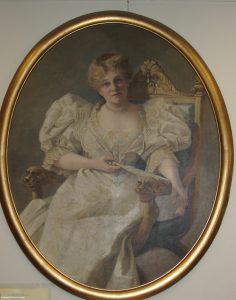
The artist George Brroughs Torrey, was born in New York City in 1863. He later lived on Fairfield Avenue in Bridgeport, exhibited in Paris, and became known for his portraits of prominent Bridgeporters such as P.T Barnum and Nathaniel Wheeler.
Torrey was commissioned to paint portraits of famous people throughout the world, including European royalty and American presidents.
In 1893 Torrey moved his studio to the Waldorf Astoria in New York. His second wife was from Hawaii, and he maintained a home in Honolulu, where he died in 1942. He is buried in Mountain Grove Cemetery in Bridgeport.
A large oval painting of an elderly woman, dressed in the fashions of the late 19th century, hangs in the History Center at the Bridgeport Public Library.
The woman, Julia Ann Tomlinson Bishop, was painted by George Burroughs Torrey with painstaking care, detailing the shimmering material of her gown.
Julia was the wife of William Darius Bishop, president of the New Haven Railroad, which was built by his father, railroad pioneer Alfred. The family’s considerable fortune was shared by Julia’s and William’s six children; Mary, Alfred, Russell, William, Darius Jr., Henry and Nathaniel.
The estate of Torrey presented several paintings to the Bridgeport Public Library. His mother, Harriet Burroughs Torrey, was a cousin to Catherine Burroughs Pettingill, who donated the original library building to the city.
Many of Torrey’s paintings are on display in the library’s Fine Arts Room, including a self-portrait, a painting of Nathaniel Wheeler and two beautiful paintings of members of his family in sailboats.
The paintings of the presidents are in storage, as is the painting of his mother, Harriet Burroughs Torrey, dressed in dark mourning clothes.
Gutchess College

A recent gift to the Bridgeport Public Library Historical Collections was this small wooden ruler, only six inches in length. The ruler had the name “Gutchess College” engraved on the side, with the addess 46 to 54 Cannon Street. What was Gutchess College? (more…)
Harvey Hubbell, II
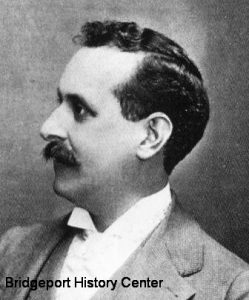
Harvey Hubbell II opened his manufacturing facility in a small loft on Middle Street in Bridgeport in 1888. Although he had some early successes in manufacturing, it was his new pull socket patented in 1896 that brought him real success.
The Hubbell pull socket, which he developed in 1896, broudght uccess to the Hubbell operation. In 1909, Harvey Hubell the second oversaw the construction of a new Bridgport factoryfor the growing company off of State Street on Bostwick Avenue.
Harvey Hubbell II took photographs of the factory being built, and was joined by his little son, Harvey III. The four story U-shaped structure was designed to increase manufacturing efficiency and like the products the company produced, utilized the newest technoklogy: reinforced concrate.
The Hubbell building, served as a western gat3way to the City’s West End industrial areafor decades to come, and was the first such building in New England.
Harvey Hubell III grew up to take over the family business after his father died in 1927. He was only 26 years old at the time of his father’s death. During Harvey III’s tenure as president of Hubell Manufacturing, the firm grew from a $1 million annual business in 1927 to a $21 million a year business in 1963.
Harvey Hubbell III in vented many of the manufacturing devices built by thee company, as had his father, Harvey II. The most remembered product made in the factory was the pull socket.
Once Interstate 95 was completed through Bridgeport, a large electric sign was on top of the Hubbell building’s roof clearly visible to automobiles on the highway.
In 2008, Hubbell Industries demolished the Bostwick Avenue plant. Hubell Industries is found throughout the world, including Shelton, Connecticut.
Igor Sikorsky
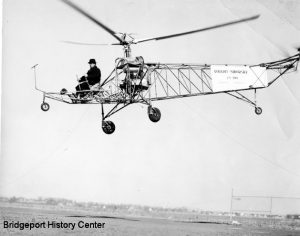
Igor Sikorsky experimented in building helicopters first in his native Russia and then in the United States. His first successful launching of a direct lift helicopter was on September 14, 1939, in Stratford. Sikorsky built his first helicopter assembly line on South Avenue in Bridgeport after receiving a contract with the U.S. government in the late 1930’s. (more…)
Ives Toys Make Happy Boys

Everyone knows that Bridgeport was a center of manufacturing of large machinery and other industries, but did you know that this city was also one of the largest manufacturers of toy trains and mechanical toys?
Edward Ives started his toy company in Bridgeport and built some of the finest clockwork toys on the market. In 1901, Ives made mechanical trains that ran on tracks.
The trains became very popular, and by 1907, Ives opened a factory on Holland street in the city’s West End.
The slogan of the company became “Ives Toys Make Happy Boys.” This became the popular slogan found in all of their catalogues.
Lionel trains began making trains along with several other toy manufacturers. Competition became keen. Lionel would actually promote that they could repair the trains for free, and Ives Toy company had trouble competing.
In 1929, Ives Toy filed for bankruptcy. Ives was sold to a competitor, however the plant was closed in 1932. The Ives toy trains that were made here are scarce but highly collectible today. If you find Ives toy train sets or Ives mechanical toys up in your attic…they are worth much more than the few dollars they were worth in 1910.
Jumping Feet First Into History
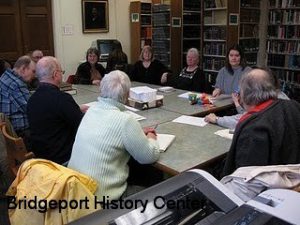
Jumping Feet First into History
Often, a connection to the past is the only thing keeping a family together.
A tremendous amount of people trace their roots from Europe, to Ellis Island, right here to Bridgeport, and they’re looking for that connection back to the Old Country. Maybe they had a family member who left Austria in 1935, and the last letter they received was from Bridgeport. Maybe they just want to know a little more about the life their ancestors lived 100 years ago.
Researchers may have no idea who their grandmother is…or even their father! But with a little question-and-answer session, we can assist patrons in jumping feet first into their history. And we can come up with some answers.
Today, a whole new audience of researchers comes in to the Bridgeport Public Library, inspired by programs like Henry Gates’ “Faces of America” on PBS and the ABC show “Who Do You Think You Are.” They want to learn who they are by finding out who their relatives — dead or alive — are.
We have Internet resources such as Ancestry.com available for free here at the library. We have books, magazines, newspapers, photographs, films — many reaching back decades, even centuries.
Our many tools will help you climb your family tree.
Our hours at the Bridgeport History Center are Thursday through Saturday, 10-5 pm. Call (203) 576-7417 for further information.
Kathleen Moore
1812-1899
The story of Kate Moore, the lighthouse keeper who kept the lights aglow in Black Rock Harbor is a wonderful tale of the sea of long ago.
In 1817, Captain Stephen Moore was injured while unloading goods from a ship. Stephen then applied for a job through the United States Lighthouse service as a lighthouse keeper. He was given the position as the Keeper of the Fayerweather Lighthouse. (more…)
Kathleen Moore, 1812-1899
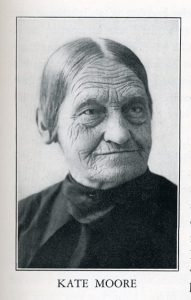
By: Mary K. Witkowski
The story of Kate Moore, the lighthouse keeper who kept the lights aglow in Black Rock Harbor is a wonderful tale of the sea of long ago.
In 1817, Captain Stephen Moore was injured while unloading goods from a ship. Stephen then applied for a job through the United States Lighthouse service as a lighthouse keeper. He was given the position as the Keeper of the Fayerweather Lighthouse. (more…)
Lake Submarine
Inventor Simon Lake believed that the undersea world contained a vast wealth of natural treasures that were waiting to be tapped.
Besides the obvious riches of fish, Lake saw a world on which a great abundance of oil could be tapped from the sea as well.
Lake was always a dreamer, and he came from a family of inventors. His grandfather invented a seed planting machine, his father invented a window shade roller and his cousin invented a telephone.
Simon Lake even named his son after Thomas Edison. It was Lake’s dream after reading Jules Verne’s 1870 book, “Twenty Thousand Leagues Under the Sea” to invent a submarine. Lake launched America’s first successful submarine in 1897.
The Lake Torpedo Boat Company was located on Seaview Avenue in Bridgeport’s East End. Often, local residents would travel down to the Long Island Sound shore in Bridgeport to sea the latest submarine being launched. The events would attract huge crowds.
In 1918, Lake began to build R-21 submarines under government contract, joining in the World War I munitions activities with the rest of the local factories.
This photograph depicts the Lake Torpedo boatyard off Seaview Avenue in 1922. Pleasure Beach is visible in the background.
Last of the Civil War Veterans
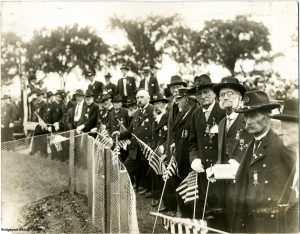
Well into the 20th century, members of the Elias Howe Jr. local veterans chapter of the Grand Army of the Republic would meet to share their memories of the Civil War and make sure that the sacrifices of the soldiers killed in the war were not forgotten. (more…)
Lewis H. Latimer, African American Inventor
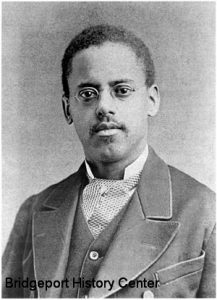
Three famous inventors – Alexander Graham Bell, Hiram Maxim and Thomas Edison – owe their successes, in part, to a young, African-American inventor who lived on Bridgeport’s South End, among a rich population of Irish, African-American, Hungarian and other ethnic groups.
Lewis Latimer lived on Whiting Street with his family. Listed on the 1880 census as a “mechanical draftsman,” Latimer invented and patented the carbon filament, worked closely with the three pioneers mentioned above, and opened the doors for future inventors.
After serving in the Navy during the Civil War, Latimer began training as a draftsman, eventually becoming a draftsman for Alexander Graham Bell in Boston, and drawing some of the first designs for Bell’s new concept of a telephone.
He left Boston in 1879 and came to Bridgeport to take a job at the U.S. Electric Lighting Company. He worked for Hiram Maxim, the firm’s chief engineer and the man credited with inventing the first portable, fully automatic machine gun, as well as the common mousetrap.
Latimer became immersed with the design and drawing of the incandescent light bulb. In fact, many believe Latimer, not Thomas Edison, to be the actual inventor of the modern light bulb.
Latimer didn’t stay long in Bridgeport, and little is known about his time here. However, it is obvious it was a turning point in his career and his work here was instrumental in developing the light bulb. It’s also known that he was a member of the Bridgeport Scientific Society, which had meetings where prominent scientists and adventurers frequently spoke, and where he presented a paper.
When the U.S. Electric Lighting Company moved to Brooklyn, N.Y. in 1880, Latimer moved there with his wife to continue his own research with a friend. Latimer continued his work in electric lighting, working in New York for the Edison Lighting Company and General Electric Company.
Lewis and his family lived in Flushing, N.Y., where he was a founding member of the community’s Unitarian Church, a member of the veterans group Grand Army of the Republic, and pursued his life-long interest in science and the arts. Lewis Latimer’s house in Flushing is preserved as a museum.
Want to learn more about Lewis H. Latimer? The Bridgeport History Center has the following materials available:
Bridgeport History Center, Newspaper clipping:Biography, Lewis Latimer
Black Inventors in the Age of Segregation: Granville T. Woods, Lewis H. Latimer and Shelby Davidson, by Rayvon Bouche, 2003.
Lewis Howard Latimer, by Glennette Tilley Turner, 1991
Margaret E. Morton: 1924 – March 10, 2012
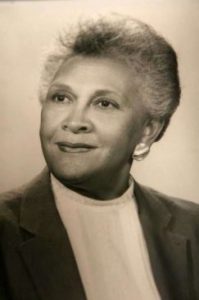
By Mary Witkowski
In these days of analyzing confusing elections and examining consequential figures in our past, people who cleared a path for our future stand out. Margaret E. Morton had an extraordinary career in Connecticut politics that was sparked by her role in a Bridgeport neighborhood issue. In the early 1970’s, she and other East End residents had asked the city to install a stop sign at the site of frequent accidents. Their request was rejected by the city, symptomatic of a growing chasm between white city leaders and East End’s black residents. (more…)
Marge Schneider: Bridgeport’s Own Rosie the Riveter
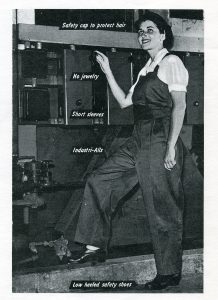
This young lady was amazing. In 1942, Marge Schneider lived with her family on Barnum Avenue near Central Avenue. With the flurry of war around her, Marge took a job at the Bridgeport Brass Company on Grand Street. Marge walked to work. (more…)
Martin Luther King Visits Bridgeport

By: Mary K. Witkowski, Bridgeport City Historian
The Reverend Martin Luther King Jr. visited Bridgeport at least five times. In March of 1961, King delivered the Frank Jacoby lecture for the. University of Bridgeport. Due to the large crowd, the lecture was held at the Klein Memorial Auditorium. More than 2,700 local residents listened to King’s enthralling words. (more…)
Neighborhoods

Bridgeport has often been called a “City of Neighborhoods.” There are commonly used designations for the various areas of Bridgeport, each neighborhood historically attracting immigrants from a variety of ethnic groups. What has become the city of Bridgeport is the mixing of citizens who moved here from all over the world.
For generations, residents have divided the city into pockets of neighborhoods. These neighborhoods are commonly known by the following names. Through history residents have strongly identified with the neighborhood they live in.
- Black Rock
- Downtown
- East End
- East Side
- North End
- The Hollow
- South End
- West End
We hope the histories written here will help to identify the who,what, why and where of Bridgeport neighborhoods.
Nellie Painter (Eleanor G. Painter)
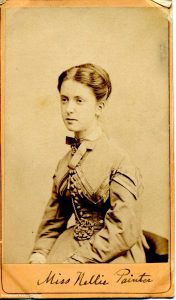
By Mary Witkowski
Eleanor Painter was, according to the Bridgeport Post March 18, 1945, a “Veteran Teacher… [a]Leader in Cultural Activities in the City since 1864.”
When Nellie Painter got to school in June of 1891, she knew she would be posing for a photograph. She had been warned by her principal, Henry D. Simmonds, that the teachers and school children would have their picture taken. “It would be fun,” Nellie thought. (more…)
OCTOBER 14, 1988: Beau Bridges Visits the Bridgeport History Center
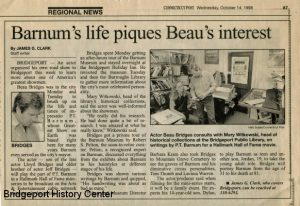
In October of 1988, actor Beau Bridges visited the Bridgeport History Center to research a new role that he was taking on for television; the Life of P. T. Barnum. The actor visited the Bridgeport History Center and the Barnum Museum in order to research and investigate P.T. Barnum’s life do that he could fully immerse himself in the role.
Olympia Brown
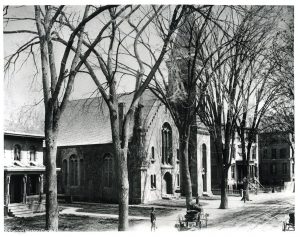
By Mary K. Witkowski
Birth: January 5, 1835, Prarie Ronde, Michigan
Died: October 23, 1926, Baltimore, Maryland
August 18th, 1920. Olympia Brown smiled to herself with satisfaction. After working diligently for the rights of women since she was young, she could at last take a deep breath. She was now 85 years old. The 19th amendment passed, giving women the right to vote! She had stood in the past with Lucy Stone, Susan B. Anthony and Elizabeth Cady Stanton. Reverend Brown had marched alongside women throughout her life, steadfast in her vision. Women had rights too! (more…)
P.T. Barnum: The Later Years
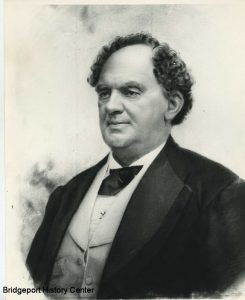
As a senior citizen, P.T. Barnum was a man who never stopped working. He never really retired and he never took it easy.
Barnum always found something new to work on. His life in Bridgeport offered a busy schedule–traveling with the circus, serving with the State Legislature, and being a one-term mayor.
The two women that the well known showman, entrepreneur and developer married may have had a lush lifestyle, but they also had a busy husband.
Barnum had his third house in Bridgeport, named Waldemere (Woods by the Sea) built in the South End in 1869. He was married to his first wife, Chaity at the time.
Charity, always ailing during the later years of their marriage, would probably preferred a smaller house. Barnum built a gigantic house, with many guest rooms and bathrooms, and large and impressive grounds.
Charity usually stayed home at Waldemere while Barnum traveled. It was on one of Barnum’s journeys in 1873 that, after 44 years of marriage, Charity died of heart failure. Barnum learned of the sad news in Germany and, grief stricken, decided to stay in Europe.
He then traveled to England to be with his old friend John Fish. Fish had a daughter Nancy who also knew Barnum.
On February 14, 1874, just 13 weeks and two days after Charity’s death, 63 year old Barnum and 22 year old Nancy Fish married in London.
Barnum returned to the United States without his new wife. In September 1874, P.T. Barnum and his young wife had a public ceremony in New York.
The following year, in 1875, Barnum was elected mayor of Bridgeport and served the one year term in effect in the 19th century. As one might expect, Barnum was not a quiet mayor. Barnum protested against the city’s saloons, he pushed for prisoners to have to work, and he strived to modernize the city’s utilities. In many ways, despite his age, he was a very modern mayor.
A modern mayor with a young modern wife, of course. So in 1889, senior citizen Barnum, after everything he had done in Bridgeport, including the winter quarters for the circus, decided he had tro build a new home.
Barnum began to build next to his old house. He wanted a brick house, without drafts. He wanted to continue living near the water, but in a house that was more comfortable. He owned the land, and he loved the location.
Barnum named his new house Marina. Barnum had a stroke in 1890 and he was confined to his new home. On April 7, 1891, P.T. Barnum died.
Part of Waldemere still stands on Rennell Street, while the other half of Waldemere was moved to 1 Pauline Street in Stratford, where it was owned by the late actress Nancy Marchand.
Barnum’s last house, Marina stood for many years at the original site. In 1961, the University of Bridgeport tore down the residence. All that remains is an iron gate with an “M” where Marina Park now stands near Seaside Park and the University of Bridgeport campus.
Today, as a tribute to Barnum, the immediate vicinity includes a Marina Park Drive and a Waldemere Avenue.
Want to learn more about P.T. Barnum? The Bridgeport History Center has the following materials available:
Bridgeport on the Sound, by Mary K. Witkowski and Bruce Williams.
Bridgeport at Work, by Mary K. Witkowski
A Pictorial History of Bridgeport, by David Palmquist.
Bridgeport History Center: Newspaper clipping file, Barnum, P.T.
P.T.Barnum
1810-1891
Phineas Taylor Barnum (P.T. Barnum) was born in Bethel, Connecticut on July 5, 1810. After a Connecticut boyhood, he became interested in entrepreneurial enterprises which included a variety of businesses, such as owning a newspaper, amusements, show business and other entertainment ideas. He ran the American Museum in New York where he exhibited acts like Tom Thumb and Lavinia Warren. He travelled throughout the world and started the 3-ring circus with partner James Bailey. P.T. Barnum became known as the World’s Greatest Showman.”
Palace and Majestic Theaters
Laurel and Hardy’s comic antics in “Way Out West,” was being viewed by hundreds of area residents the summer of 1937.
Since the theaters opened to the public in 1922, the grand building in downtown Bridgeport became the place to be seen. By 1939, the Majestic Theater had a special party to celebrate the theater’s “Ten Millionth patron,” a landmark occasion celebrating the 17th anniversary of the Majestic.
Mrs. Richard G. Rossbaum of Stratford was the purchaser of the 10,000th ticket to be sold at the theater. Mrs. Rosenbaum won free tickets for the next six months.
When the theater originally opened on November 4, 1922, Eddie Cantor was on stage in a revue called “Make It Snappy.” The theaters were built by Sylvester Poli. Poli hired the foremost theater architect of the day, Thomas Lamb.
For many years, the Majestic featured “follies,” which used Bridgeport talent from the local dancing school. In 1934, Loew Theaters bought the Poli Theater and both the Palace and the Majestic began to show movies. Films were shown around the clock, so that workers in the area could see movies when their work shifts ended.
In 1972, when factories started to close and workers were more temped to stay home and watch t.v., the theaters closed.
Over the years, the theaters have stood as a monument to Bridgeport of the 20th century. The theaters are virtually intact inside, however funding for restoration has not occurred. The Waterbury Palace, also a the Poli/Lamb creation, looks very much like the Bridgeport theaters. The Waterbury theaters were restored in 2003. To visit the site of the Waterbury Palace and see what the Bridgeport theaters could look like if restored visit http://www.palacewaterbury.com/index.shtml
President Kennedy in Bridgeport November 6, 1960

The crowd of 6,000 came to see then Senator John F. Kennedy. The crowd,as estimated by Superintendent of Police Francis J. Shanley, cheered when Kennedy said that Connecticut was a key state in the election.
“The nation will have its eyes on Connecticut,” Kennedy told the crowd. (more…)
Sam Liskov
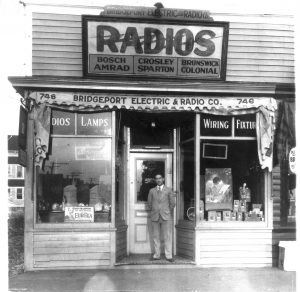
Sam and his brothers Kiev and Elliot owned a radio shop located at 746 Madison Avenue, Bridgeport in 1932. An oral history with Sam Liskov can be read on the website
http://bridgeporthistory.org/
Some Genealogical Musings by Roger Ratzenberger
Roger Ratzenberger, the cousin of actor John Ratzenberger, is a regular researcher in the Bridgeport History Center. This wonderful story of genuine genealogy research gives great insight into the jounery that genealogy can take you on. Start the trip at the Bridgeport History Center, and you will be hooked!
Genealogy research is a fun and rewarding endeavor. It’s not
just about dates and relationships but the “color” that you can bring to your
family history. If you’re lucky, you’ll uncover some unexpected pleasant
surprises.
Growing up, I spent a lot of time at my grandparents’ (Dewey
and Josephine Riccio Simmons) home. Dewey was not only my grandfather, but also my best friend. On our numerous fishing trips my grandfather shared many
stories of his youth – stories about fishing and hunting and growing up near
and playing in Howe’s Cavern. There were many stories about all of the fun he
had growing up.
One story that stands out in my mind seemed to be more of a
tall tale than a factual recollection. I remember my grandfather telling me about having a tooth knocked out as he was hit in the mouth with a baseball. He said that he picked it up off the ground wiped it off, stuck it back in place and it grew back into place. I was fascinated with this story when I was young but as I grew older, it was one of those “recollections” that seemed to be more tall tale than fact.
I didn’t get the genealogy bug until after my grandfather died and I regret that to this day. His ancestors came to the United States in the 1600’s and had a long history in Schoharie County. With all of the information that I have found on his side of the family, his father, Oscar, has been most elusive.
Oscar Simmons lived in Cobleskill around of the turn of the century with his wife Carrie Dibble Simmons and their seven children: Harry, Ada, Charles, Melvin, Dewey, Dorothy and Nelson. Family legend has it that he left his wife
and kids sometime early in the 1900’s with a married woman and a stolen team of
horses.
In my quest to find Oscar, I made a connection with Linda
Robinson, a genealogy researcher in Ontario, Canada via the internet. She was
doing research on the Schoharie area and was transcribing Worcester Times articles from microfilm. She found and sent me a few articles on births, deaths and
marriages of some of my ancestors. The information filled in gaps in my family
tree, but alas, she was unable to find much more about Oscar.
What I did find out was that although he may have run away
with another woman, he was apparently an honest fisherman, at least according
to an interesting article turned up Thursday, April 23, 1908 on page 5, column 2:
An Honest Fisherman
One of the noblest instances of self-sacrifice on the part of a trout
fisherman is that credited to O. M. Simmons, the Worcester barber. Last Thursday, the opening day of the season, he was fishing near the beaver dam
with rather discouraging luck, when his attention was directed to a muskrat
hole in the bank. More as an experiment rather than for any other reason he
dropped his hook, with a huge night-walker impaled, into the hole. He felt something take the bait, and from the struggle which followed “Sim” was convinced that he had hooked a muskrat. At least he dragged his catch through the mouth of the hole and found that he had landed the largest brook trout he had ever laid his eyes on. He measured the fish with a certified tape and it was exactly 28 inches long. It weighed eight pounds. “You are too big to be true,” said the honest barber with a sigh. “Even if I took you home no one
would believe it. My reputation must not suffer.” And he threw the big fish back into the creek. Worcester is the county seat for honest fishermen.
From the articles that Linda found, we were able to determine that sometime between 1915 and 1918, Oscar had fled the scene in one way or another. But there was no smoking gun.
Linda was a wonderful lady and pleasure to work with. In appreciation for her help, I sent her a check to buy a couple of more rolls of the Worcester Times microfilm.
Not to give up that easy, I wrote to the Worcester Town Historian, Marilyn Dufresne, looking for some more traces of Oscar. I explained the little I knew about him, from the family legend to information from the articles in the Worcester Times. One of those articles described Oscar’s trip to purchase two “Hydraulic” chairs for his barber shop. It turned out that Marilyn was keenly interested in that article. As it turned out, she had two “Hydraulic” chairs in the Worcester Historical Museum. Apparently, these had been attributed to another barber, Raymond Potter, who just happened to have followed Oscar in the same location as his shop. Marilyn provided me with some more information including photographs of the chairs.
With the information in Worcester exhausted, I turned next to the Federal census records. Thank goodness records were searchable electronically via the internet (ala Ancestry.com). In the 1920 census, I was able to locate Oscar in Framingham, New Hampshire listed as single and living with a single woman, Anna M. Olmstead … his niece! In the 1930 census, I was able to find them again, this time living in Greenfield, New Hampshire. With this information, and a visit to Greenfield’s online cemetery burial records, I found that Oscar and Anna were buried in Greenvale Cemetery.
With that information in hand, I took a quick trip to Greenfield and Greenvale Cemetery. I may have found his final resting place, but the plot thickened. Knowing the year of his death from his gravestone, I could now try to find his death record.
Just down the road from the cemetery was the Stephenson library so I figured it would be worth making another stop while in Greenfield. There the librarian pointed me to a book on the history of the town, “The Story of a Town 1791-1976 Greenfield, New Hampshire”. It turned out that I was lucky to found him in the 1930 census as the book indicated that he had just moved there in 1930. There he opened a store and “carried on” a barber shop.
That was the extent of what I was able to find on my visit to Greenfield so I next attempted to locate a death certificate. The Greenfield vital statistics office referred me to the State of New Hampshire. I must admit that I was completely disappointed when I received a response that said that not only was there no record of his death in Greenfield in 1946, but none in the entire State of New Hampshire. Either he died out of state or the records were lost.
I found answers to many of my questions and information that I never expected. This has provided the “color” that makes Oscar more than just a name to me, more of a multi-dimensional character. I do, however, seem to have just as many questions, albeit different ones, as I started with. Always keep looking and follow all, even seemingly insignificant leads; you never know what you’ll find. That’s where I remain stuck today – my quest for more information about Oscar continues to this day.
Oh, remember about that story my grandfather told me about his tooth? Imagine my surprise the next time I heard from Linda. She contacted me about an article that she found on a roll of microfilm she had purchased with my check. The “news story” turned up in the June 10, 1914 edition of the Worcester Times, page 5, column 1.
While playing ball the other day a foul tip knocked out an upper front
tooth for Dewey Simmons. Dewey picked up the tooth placed it back in position and says “it is just about as solid as ever.”
That was the last I heard from Linda. I later found out that she had passed away.
So make sure to capture all of those stories and family legends. It just might turn out that some of those stories that sound a little far-fetched may actually turn out to be more fact than fiction. If nothing else, they make the search much more interesting and provide opportunities to make your ancestors more real for generations to come.
Genealogy is like putting together a puzzle without knowing what it should look like in the end. In fact, the beauty of it is that there is no end. You can spend as much time researching as you can and you will never be finished. Remember, it’s all about the journey and never forgetting where you came from.
The Day Lincoln Came to Bridgeport
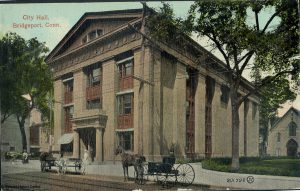
Abraham Lincoln was still a Republican candidate for president when he came to Bridgeport on March 10, 1860.
It was a Saturday night and Lincoln was scheduled to give his talk downtown in Washington Hall, a lecture room in the Fairfield County Courthouse, which is now known as McLevy Hall. According to a small notice in the newspaper, Lincoln’s speech would “commence precisely at 7 o’clock, as he is obliged to leave on the Express train at 9:07 pm.”
Lincoln arrived in Bridgeport to the music of the Wheeler and Wilson Band and a reception of some 100 members of the Republican Committee.
According to a local newspaper report at the time, “a great crowd attended at Washington Hall on Saturday evening to hear the Honorable Mr. Lincoln of Illinois. No special means had been used to ensure a large attendance and no posters were got out.”
Lincoln spoke for two hours, giving much the same speech he had given in New Haven four days earlier, which was described as “an impassioned political speech against slavery.”
The Daily Standard described Lincoln as a “tall, bony, angular, big jointed figure with a great towering head and very expressive countenance. His eye satisfies you at once that there is brain…intellectual power in the man, and this is the secret of his success.”
The crowd followed Abraham Lincoln to the train and applauded and cheered as the train left.
The Entrance to Beardsley Park, Bridgeport CT
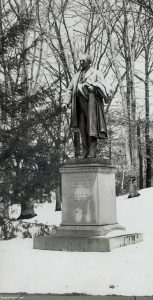
Greeting visitors to Beardsley Park is a statue of the man who donated the land to the city of Bridgeport, James Walker Beardsley.
Legend has it that Beardsley decided to give the land to the city after seeing an irate farmer tell children to leave a meadow where they were playing.
Trying to guarantee that future generations of Bridgeport children would have a place to play freely, Beardsley, also a farmer donated the land to the city in 1878.
Fredrick Law Olmstead, landscape architect of Central Park in New York City as well as Seaside Park, designed Beardsley Park.
Beardsley, using his agricultural background, advised park officials on the planting of trees and other shrubs and designed bridges and special roads.
Beardsley and his sister lived in a house near Beardsley Park. On Christmas Eve in 1892, intruders broke into Beardsley’s home and attacked the two, who were elderly.
James Beardsley died on New Year’s Day, 1893, at age 72, due to complications from the wounds inflicted by the thieves.
The bronze statue of James Beardsley was dedicated on June 19, 1909. The Bridgeport Board of Trade raised money for it by public subscription, appropriating $6,000. The statue was designed by Charles Henry Niehaus.
The First Settlers of Black Rock
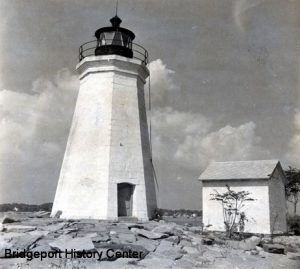
In 1644 a group of intrepid pioneers left Concord, Massachusetts and landed at Black Rock. Some settled in “Greenlea,” the rocky, marshy area that later became Seaside Park. But Thomas Wheeler (more…)
The Quilts and The Women from Gee’s Bend
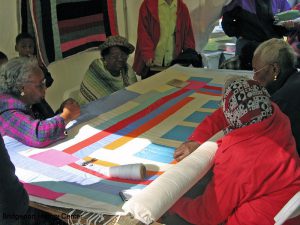
Many Bridgeport residents have strong ties to the farming community in Alabama known as Gee’s Bend.
Gee’s Bend was part of a larger plantation on the Alabama River that came into existence around 1830. After the Civil War, when the former slaves were given the option to own their own land in the area, a small community of black residents continued to live off this land. (more…)
Viola Louise Smith Bridgeforth: Making the Most From Extraordinary Times

By Mary K. Witkowski,
Editor: Ann Marie Virzi
In her 99 years on earth, Viola Bridgeforth, born in 1897, lived through many if not most of the profound changes that African-Americans and women in general experienced in the 20th century. Through all the changes, Viola Bridgeforth remained steadfastly focused on what mattered. (more…)
Walt Kelly: Creator of Pogo
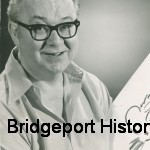
By: Mary K. Witkowski, Bridgeport City Historian
Cartoonist Walt Kelly, who created the comic strip “Pogo,” about a group of swamp animals that discuss politics, developed his talent as a young man here in Bridgeport.
Born Walter Crawford Kelly, Jr. in 1913 in Philadelphia, Walt Kelly moved with his parents, Walt Sr. and Genevieve, and sister Bernice, to 457 East Avenue in Bridgeport’s East End. His parents worked at General Electric. In the 1930 census, it shows that Genevieve also worked for General Electric.
Walt went to Harding High School, where he began a long interest in drawing. He drew for the high school yearbook and the school newspaper before graduating in 1930. The Bridgeport Post employed Walt as a cartoonist. Kelly drew a cartoon version of the life of famed showman and Bridgeport mayor P.T. Barnum.
Kelly took a job at Disney studios in California in 1936, working on many of the company’s animated films.
His health prevented him from serving in World War II, so instead he took a job with Dell comics, where he developed the Pogo character — an anthropomorphic possum who discussed politics with an alligator, porcupine and various other animals, many thinly veiled caricatures of political figures of the day.
After World War II, Walt took a job working for the New York Star, where he became a political cartoonist.
With the syndication of “Pogo” in newspapers throughout the country, Kelly, his political satire and even the Okefenokee swamp became famous.
Walt Kelly died in 1973 in California. His second wife, Selby, continued to draw the series for two years after his death.
Want to learn more about Walt Kelly and Pogo? The Bridgeport History Center has the following materials available:
World War I Diary: 100 Years Ago
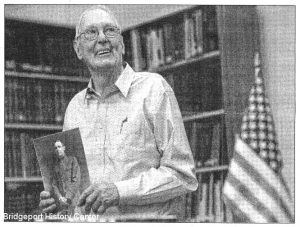
What a wonderful gift! The staff of the Bridgeport History Center got an idea. One hundred years ago, World War I started. We wanted to do an exhibit. Just after the initial thought, the phone rang.
I answered and heard the voice of Vincent Keating. “Would you be interested in a diary and other things from World War I?” (more…)
World War II Ration Books
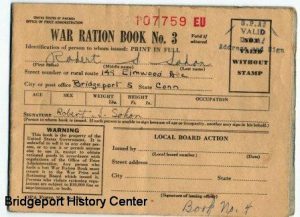
Think times are tough now? Imagine what it was like during World War II, when rationing meant you couldn’t always buy the goods you wanted.
Many of the commodities we take for granted today were in short supply during World War II, because of the needs of US soldiers fighting overseas. So, citizens back home were given a series of ration books. Each book was numbered, and the stamps inside controlled people’s consumption of things like food, gasoline and even clothing.
